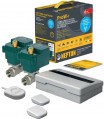Max. number of sensors
The largest number of leakage sensors allowed for simultaneous connection to the control unit. Essentially, this parameter determines the number of places that can be protected from leaks using a particular system. An apartment building or a small office rarely requires more than 10–15 sensors, but large buildings may need several dozen, or even hundreds of them.
Note that the number of sensors in a set (see “In box”) is often less than the maximum possible — in the expectation that the customer will complete the system with the required number of sensors as needed. It is also worth saying that this paragraph takes into account all types of sensors — both wired and wireless. If the kit allows both connection methods, then the number of supported wireless sensors is specified separately in the specifications.
Of which wireless
The maximum number of wireless leak sensors supported by the system.
Such sensors are more convenient to install than wired ones, since they do not require laying cables. In some cases — for example, when installing a leak detection system in a hose with finished renovation — this can be a fundamental advantage. The downside to this convenience is the higher cost and the need. As for the number of wireless sensors, it is separately specified only if the system supports both types of sensors — both wired and wireless. The choice regarding this parameter is quite obvious: it all depends on how many control points need to be covered by the leak detection system. It should be taken into account that the number of sensors in the kit may be less than the total number supported by the system.
Valve exercise function
The frequency with which the system carries out preventive maintenance to
protect the valve from jamming.
Jamming can occur if the valve has been in a stationary position for a long time: deposits appear on its internal parts that interfere with the movement of these parts. To avoid this, with a certain frequency (once a month, once every half a month or once a week), valve exercise can be turned on: the device closes and opens the valve several times. The more often this process is carried out, the less likely it is that the valve will become dirty and will not be able to function normally.
Control via smartphone
The ability to control the system from a smartphone, tablet or other gadget with a special application installed.
Such an application allows you to at least comfortably check the status of the system and control the opening/closing of valves. Using a smartphone/tablet is much more convenient than getting to the installation site of the control unit (and even more so a valve with a built-in control unit) every time. In addition, the application may provide other functions, including quite specific ones (for example, opening/closing valves on a schedule). However, the communication options with the control gadget may be different. Thus, in some models
, control via smartphone is available via the Internet and can be carried out from anywhere in the world where there is access to the World Wide Web. In others, communication is carried out only locally, directly on site, although the communication range in such cases may well be tens of meters. It also wouldn’t hurt to clarify these details before purchasing.
Power supply
The type of power for which the system is designed.
—
230 V. Power is supplied from a standard household outlet with a voltage of 230 V. The device itself often has a built-in power supply that reduces the voltage to a safe level (5 - 12 V) in case of contact with water.
—
12 V. Powered by DC voltage 12 V. As a rule, this marking means that the device actually operates from the same 230 V network, but uses an external power supply. From a safety point of view, this option is convenient because the external adapter is located directly in the outlet and all dangerous voltage remains in its same area - a wire with a reduced voltage goes to the device. It may also be possible to connect directly to low-voltage DC networks, but this point should be clarified separately.
—
4.5 V. This option usually means battery power. Such devices do not depend on sockets, and the voltage in them is absolutely safe for humans. True, the batteries need to be changed periodically, but their continuous operation time often reaches several months, or even years.
—
Battery. This option may imply both the main power supply of the system from the built-in battery or replaceable energy sources, and backup power supply in case of power outages. The batteries maintain a charge for a long time, thanks to which the leakage
...protection system functions properly regardless of the presence of voltage in the electrical network. This ensures proper detection of leaks and rapid response to them.Alarm
Types of alerts provided in the protective system.
— Sound. Notification of various events with a sound signal. The most common use is to sound an alarm when a leak is detected to draw attention to the problem and possibly contain the water that has already spilt and prevent damage. In addition, there may be other reasons for sound notification — for example, a critically low battery.
—
Wire break alarm. Notification of a broken wire going to the wired sensor. Protective systems with this function during operation constantly monitor the connection with the sensors and give a signal when a break is detected. This avoids situations where the sensor does not work due to damage to the connecting wire.
—
Valve failure alarm. Leak detection systems with this function periodically check the operability of the valves and if problems are detected, they issue a warning. This reduces the likelihood that the valve will be broken and will not be able to perform its function.

